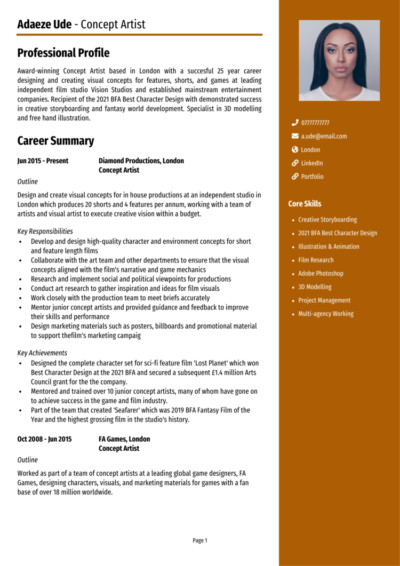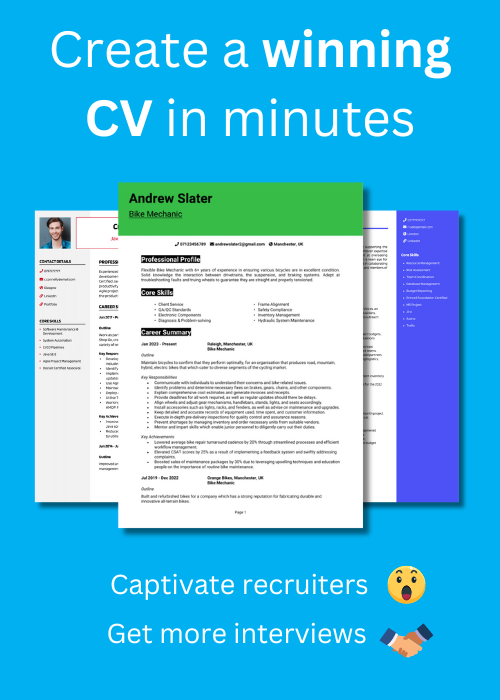Before a single frame is rendered, it’s your imagination that sets the tone. Concept artists create the blueprints for the entire visual world – and now it’s time to focus that creativity on your own career path with a winning CV.
This guide and its Concept Artist CV example will help you present your artistic strengths, design thinking, and collaborative experience in a CV that feels as carefully constructed as your best portfolio pieces.
Concept Artist CV
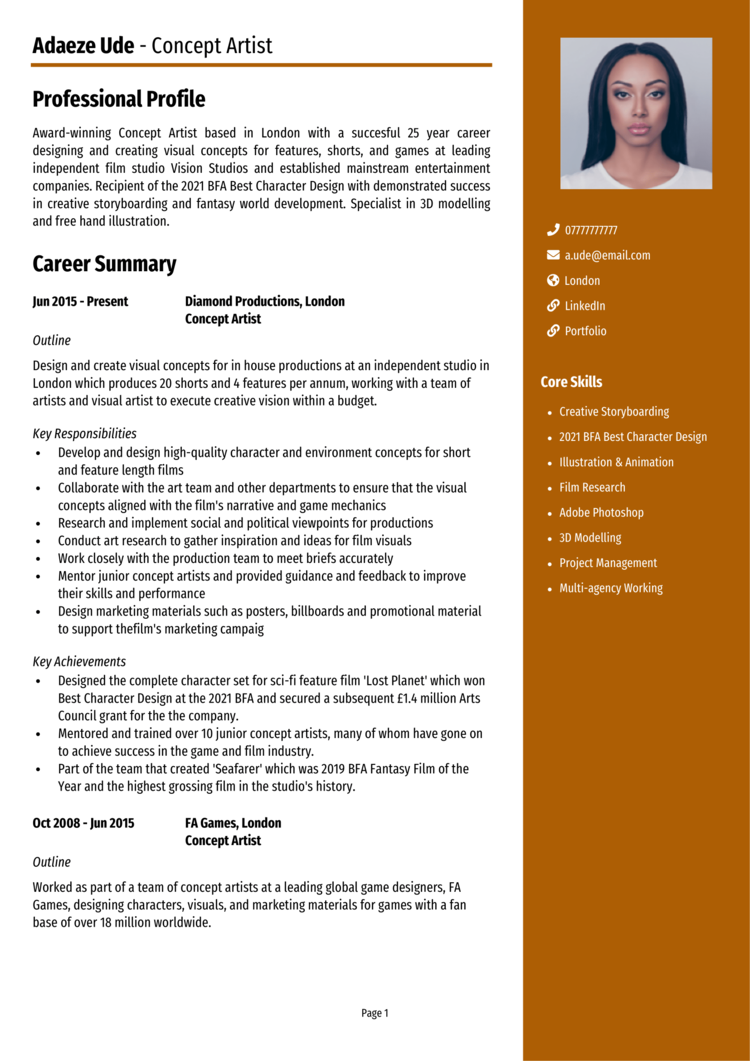
How to write your Concept Artist CV
Discover how to craft a winning Concept Artist CV that lands interviews with this simple step-by-step guide.
Your work speaks volumes visually, but your CV needs to hold its own in text. It should outline your creative process and adaptability – whether you’re designing characters for games or environments for film.
In the next sections, you’ll learn that writing a CV involves shaping your background into a clear, structured document that complements your portfolio and convinces employers you’re the right artist to bring their ideas to life.
How to structure and format your Concept Artist CV
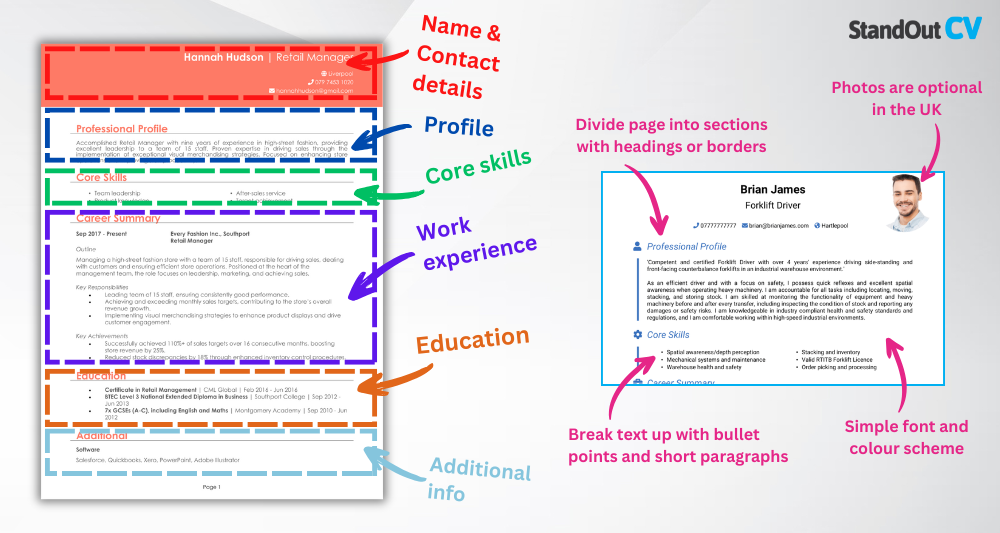
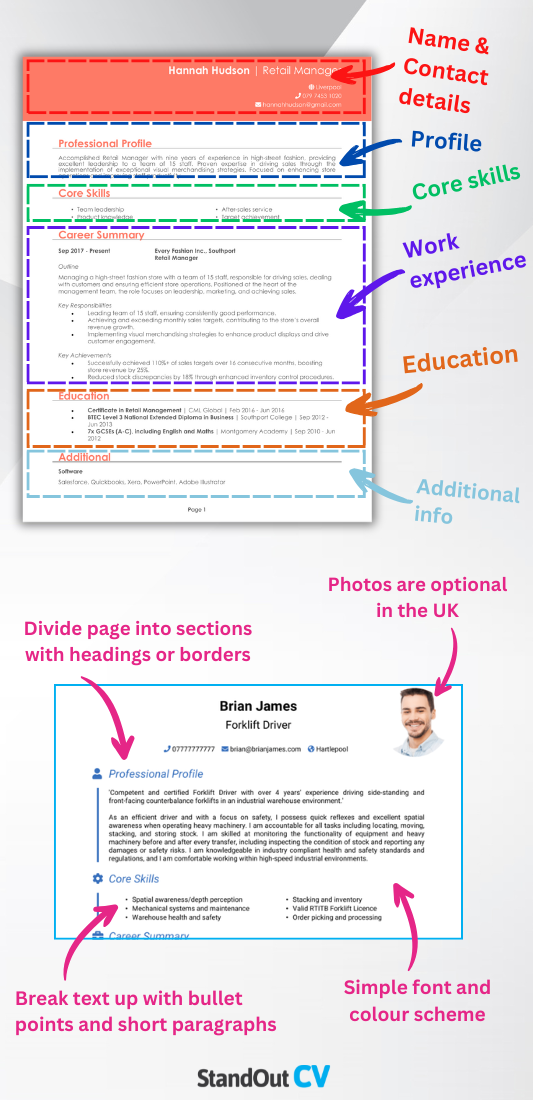
As a concept artist, you know the value of flow and first impressions – and your CV should reflect the same principles. A strong structure helps recruiters and art leads quickly pick out your experience, specialisms, and the studios or projects you’ve worked on. An incoherent list full of mistakes will only make hiring managers look at other candidates, so your CV should all fit together nicely.
Here’s the layout to follow:
- Name and contact details – Place your name and personal details prominently at the top of your CV for quick access. Adding a photo is up to you.
- Profile – Open with a compelling overview of your skills, experience, and career goals.
- Core skills – List your key abilities in this section, focusing on those that will be most relevant to the job.
- Work experience – Provide a detailed breakdown of your work history, starting with the most recent job first.
- Education & certifications – List your qualifications, including degrees and relevant certifications, in reverse chronological order.
- Additional info – Optional extras like exhibitions, awards, languages, or relevant hobbies.
Use bullet points in your experience section to make details quick to scan. Stick to a clean, professional font – let your work provide the visual flair, not the typeface. Keep your CV length to two pages, and always make sure your portfolio is easy to find and up to date. A well-presented format will show that you’ve got the right skills for recruiters.
How to write a Concept Artist CV profile


This section is where you establish your creative identity. Use it to give studios or hiring managers a sense of what you specialise in, what kinds of projects you’ve worked on, and what makes your work stand out. Your goal in the CV profile is to convince recruiters that you’re the candidate who will bring real, tangible value to their project.
Concept Artist CV profile examples
Profile 1
Creative and detail-oriented Concept Artist with five years of experience designing characters, environments, and visual assets for video games and animation. Skilled in both traditional and digital illustration, with a strong grasp of composition, lighting, and storytelling. Proficient in Photoshop, Procreate, and Blender, with experience collaborating in agile development pipelines and adapting to diverse art styles.
Profile 2
Imaginative Concept Artist with four years of experience in the entertainment industry, supporting game development and film pre-production. Adept at producing mood boards, thumbnails, and fully rendered concept art. Strong ability to take creative direction and translate narrative ideas into engaging visual designs. Comfortable working independently or within a larger art team.
Profile 3
Versatile Concept Artist with a background in visual development and a passion for world-building. Experienced in crafting unique character designs, props, and fantasy landscapes for indie games and multimedia projects. Skilled in using Adobe Creative Suite and 3D tools for paint-overs and composition. Known for a strong work ethic, creative problem-solving, and consistent artistic quality.
Details to put in your Concept Artist CV profile
Here’s what to include:
- Where you’ve worked – Game studios, animation houses, film production, or freelance clients.
- Your top qualifications – Degrees, diplomas, or concept art training programmes.
- Essential strengths – Composition, storytelling, digital painting, collaboration.
- Areas of focus – Characters, creatures, environments, props, or worldbuilding.
- Creative approach – Your process, style, and how you adapt to different briefs or pipelines.
What to include in the core skills section of your CV


This section offers a quick-fire look at your creative toolkit. Focus on technical and stylistic proficiencies that are relevant to the role – without turning this into a software checklist. Think about what you’re known for: your speed, your eye for mood, or your ability to work across multiple aesthetics.
Keep this tailored and tight so it reflects the job you’re aiming for: focus on hard CV skills rather than generic abilities which recruiters will just overlook.
What are the most important skills for a Concept Artist CV?
- Visual Concept Development – Creating original sketches and illustrations to visualise ideas, characters, environments, and props for games, films, or animation.
- Character and Creature Design – Designing unique and expressive characters or creatures that align with story, tone, and style.
- Environment and World Building – Producing immersive landscape and location concepts that support narrative and gameplay objectives.
- Mood and Style Exploration – Establishing colour palettes, lighting, and atmosphere to define the visual tone of a project.
- Iteration and Refinement – Developing multiple versions of concepts based on feedback and project evolution.
- Digital Painting and Illustration – Using tools like Photoshop, Procreate, or Krita to produce high-quality concept art.
- 3D Integration Awareness – Creating concepts with consideration for 3D modelling, animation, and game engine implementation.
- Collaboration with Art and Design Teams – Working closely with art directors, game designers, and animators to ensure cohesive visual storytelling.
- Reference Gathering and Research – Collecting visual inspiration and conducting research to inform design choices and authenticity.
- Portfolio and Presentation Skills – Compiling and presenting concept art in a clear, professional manner for team reviews and stakeholder approval.
How to write a strong work experience section for your CV


This is where you show how your designs moved from concept to creation. Whether you’ve worked independently or within a studio, your experience should demonstrate how you interpret briefs, collaborate with teams, and translate ideas into visuals that shape final products.
List your work experience from the most recent first. Include your job title, the client or studio, and your dates. Then use bullet points to explain what you did on each project and how you did it. Show both the creativity and the reliability behind your work.
The best way to structure job entries on your CV

- Outline – Briefly describe the client or project context and your role in it.
- Responsibilities – Use action words like “conceptualised,” “illustrated,” “designed,” or “collaborated.”
- Achievements – A great tip is to use numbers to show the specific impact of your achievements: “Created 50+ character concepts for launch title,” “Helped establish visual direction for 3D adaptation,” or “Worked alongside 12-person team across agile development cycles.”
Sample jobs for Concept Artists
Concept Artist | Iron Wisp Games
Outline
Created visual development assets for a fantasy RPG title, working alongside art directors and 3D modellers to define the visual language of the game.
Responsibilities
- Designed character concepts, environment thumbnails, and props based on creative briefs.
- Produced paint-overs and callouts for 3D artists to guide asset modelling.
- Participated in world-building workshops and visual ideation sessions.
- Developed mood boards and visual benchmarks to maintain artistic consistency.
- Reviewed team artwork and provided feedback to support style alignment.
Achievements
- Delivered over 150 production-ready concept assets over two development cycles.
- Helped reduce revision time by 30% through clear visual documentation.
- Praised for versatility in adapting to different themes and art directions.
Concept Artist | Studio Valken Visuals
Outline
Supported pre-production for a short animated film, contributing character and background designs from concept to colour key.
Responsibilities
- Collaborated with writers and directors to visualise key narrative moments.
- Developed character turnarounds, facial expressions, and costume variations.
- Designed interior and exterior environments with lighting and mood considerations.
- Created colour keys to guide the animation team’s palette and lighting setups.
- Worked under tight deadlines while maintaining visual fidelity and creativity.
Achievements
- Contributed to a film that won a regional animation festival award for art direction.
- Recognised for strong storytelling through design and use of colour in scene composition.
- Helped refine the visual tone that was later adopted across marketing materials.
Concept Artist | Freelance
Outline
Produced concept artwork for indie developers, short film creators, and tabletop publishers on a freelance basis, handling a variety of project scopes and art styles.
Responsibilities
- Worked directly with clients to understand briefs, timelines, and stylistic preferences.
- Created concept sheets, turnarounds, and mock-ups for fantasy and sci-fi IPs.
- Managed workflow independently using tools like Trello and Google Drive.
- Handled revisions, feedback, and file delivery to client specifications.
- Maintained a professional online portfolio to attract new commissions.
Achievements
- Completed over 40 freelance projects for clients across North America and Europe.
- Built a strong referral network through consistent quality and communication.
- Recognised for adaptability and reliability by repeat clients in the indie games space.
How to list your educational history


Your education shows you’ve developed strong fundamentals – composition, anatomy, colour theory, or design thinking. Start with your most recent qualification and work backward. Include degrees, diplomas, art school training, and any supplementary courses that support your role (e.g. environment design, figure drawing, storytelling).
Even if you’re self-taught, this section can include workshops, mentorships, or online programmes – as long as they contributed to your growth and skillset.
What are the best qualifications for a Concept Artist CV?
- BA in Concept Art, Illustration, or Game Art – A formal foundation in design, storytelling, and visual communication.
- Diploma in Digital Art or Visual Development – Provides hands-on, specialised training.
- Online Industry Courses (e.g. Learn Squared, CGMA, Schoolism) – Shows ongoing development in industry-relevant techniques.
- Foundation in Art & Design – Supports traditional art skills essential for visual storytelling.
- Software Certifications (e.g. Adobe Photoshop, ZBrush) – Reinforces your technical competency.


